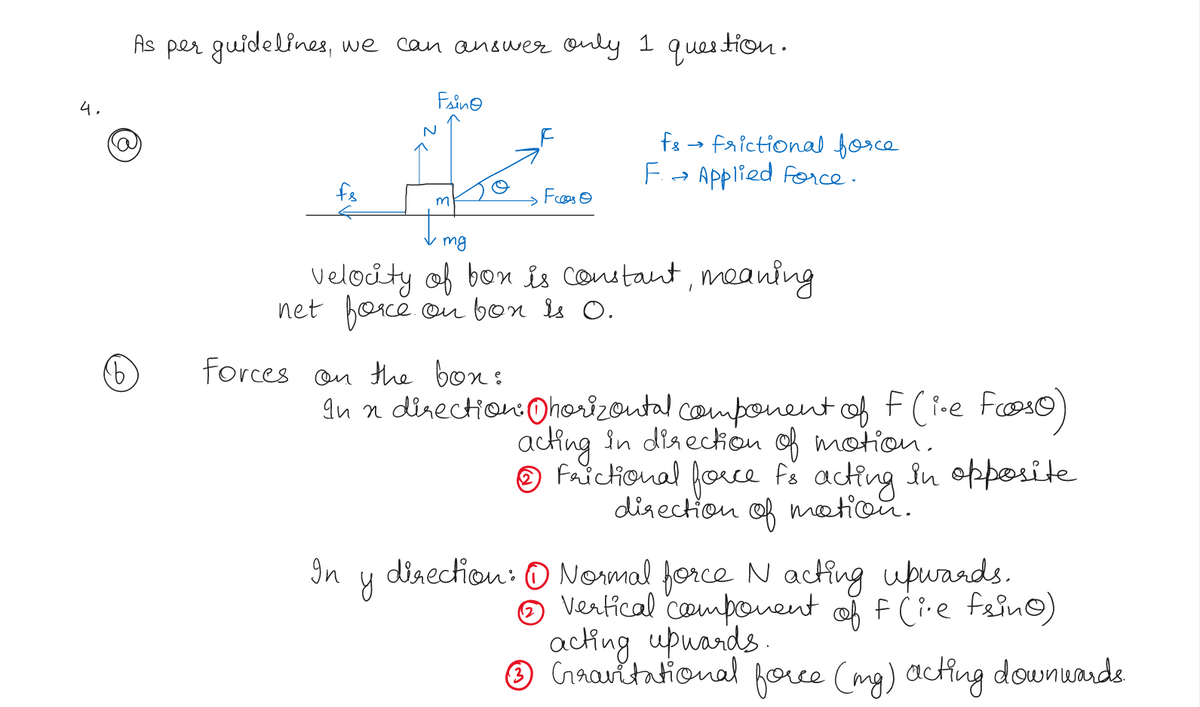and the floor. c The applied pulling force is steadily increased. Just before the box moves forward, the 144.0 N. Determine the maximum coefficient of friction between the box and the surface. 4. The same box is being pulled by a force, F, at an angle, 0, above the horizontal, across a rough surface at a constant velocity. a Draw a free-body diagram of the box. b. Identify the forces acting on the box in the x- and y-axes. c Will the frictional force increase or decrease as 8 is increased from 0° to 45°? Explain your reasoning. lid materials, write a procedure for how fiction. Be sure to
and the floor. c The applied pulling force is steadily increased. Just before the box moves forward, the 144.0 N. Determine the maximum coefficient of friction between the box and the surface. 4. The same box is being pulled by a force, F, at an angle, 0, above the horizontal, across a rough surface at a constant velocity. a Draw a free-body diagram of the box. b. Identify the forces acting on the box in the x- and y-axes. c Will the frictional force increase or decrease as 8 is increased from 0° to 45°? Explain your reasoning. lid materials, write a procedure for how fiction. Be sure to
College Physics
11th Edition
ISBN:9781305952300
Author:Raymond A. Serway, Chris Vuille
Publisher:Raymond A. Serway, Chris Vuille
Chapter1: Units, Trigonometry. And Vectors
Section: Chapter Questions
Problem 1CQ: Estimate the order of magnitude of the length, in meters, of each of the following; (a) a mouse, (b)...
Related questions
Question
100%
Need help with with 4 and 5

Transcribed Image Text:b. Calculate the mass m of the box.
2. The same box now encounters a rough surface and moves with a constant velocity.
a Draw a free-body diagram of the box, and identify the force opposing the motion.
b. Determine the coefficient of friction between the box and the surface.
3. The same box is then pulled over an especially rough surface and comes to a stop. The pulling force is still
applied and the box does not move.
a Draw a free-body diagram of the box, and identify the force opposing the motion.
Dox assuming the floor is frictionless.
b. The applied pulling force is increased to 70.0 N. The box remains stationary. Determine the coefficient of
friction between the box and the floor.
c The applied pulling force is steadily increased. Just before the box moves forward, the force is recorded to be
144.0 N. Determine the maximum coefficient of friction between the box and the surface.
4. The same box is being pulled by a force, F, at an angle, 8, above the horizontal, across a rough surface at a
constant velocity.
a Draw a free-body diagram of the box.
b. Identify the forces acting on the box in the x- and y-axes.
c Will the frictional force increase or decrease as 0 is increased from 0° to 45°? Explain your reasoning.
5. Considering your answers to Prelab Questions 2, 3 and 4, and the provided materials, write a procedure for how
you would determine the coefficient of kinetic (sliding) friction and the coefficient of static friction. Be sure to
define the conditions of the system in your procedure.
Expert Solution
Step 1

Step by step
Solved in 2 steps with 2 images

Knowledge Booster
Learn more about
Need a deep-dive on the concept behind this application? Look no further. Learn more about this topic, physics and related others by exploring similar questions and additional content below.Recommended textbooks for you

College Physics
Physics
ISBN:
9781305952300
Author:
Raymond A. Serway, Chris Vuille
Publisher:
Cengage Learning

University Physics (14th Edition)
Physics
ISBN:
9780133969290
Author:
Hugh D. Young, Roger A. Freedman
Publisher:
PEARSON

Introduction To Quantum Mechanics
Physics
ISBN:
9781107189638
Author:
Griffiths, David J., Schroeter, Darrell F.
Publisher:
Cambridge University Press

College Physics
Physics
ISBN:
9781305952300
Author:
Raymond A. Serway, Chris Vuille
Publisher:
Cengage Learning

University Physics (14th Edition)
Physics
ISBN:
9780133969290
Author:
Hugh D. Young, Roger A. Freedman
Publisher:
PEARSON

Introduction To Quantum Mechanics
Physics
ISBN:
9781107189638
Author:
Griffiths, David J., Schroeter, Darrell F.
Publisher:
Cambridge University Press

Physics for Scientists and Engineers
Physics
ISBN:
9781337553278
Author:
Raymond A. Serway, John W. Jewett
Publisher:
Cengage Learning

Lecture- Tutorials for Introductory Astronomy
Physics
ISBN:
9780321820464
Author:
Edward E. Prather, Tim P. Slater, Jeff P. Adams, Gina Brissenden
Publisher:
Addison-Wesley

College Physics: A Strategic Approach (4th Editio…
Physics
ISBN:
9780134609034
Author:
Randall D. Knight (Professor Emeritus), Brian Jones, Stuart Field
Publisher:
PEARSON